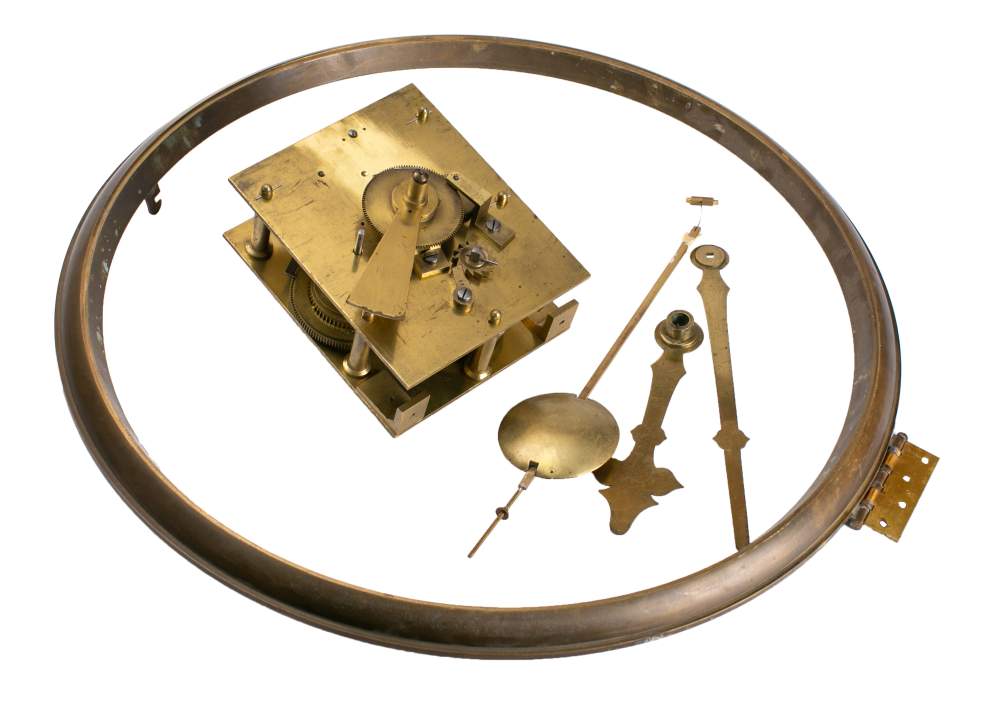VULLIAMY, LONDON: A FINE 19TH CENTURY TORTOISESHELL TABLE CLOCK, NO. 1340, CIRCA 1837 by Benjamin Lewis Vulliamy (1780-1854) Royal Clockmaker. in the French Boulle style, the case with caddy top surmounted by an acorn and oak leaf ormolu finial, the waisted sides with gilt bronze arched panels enclosing pierced brass scrolling foliate frets, raised on four rocaille cast feet, the fluted and foliate bezel enclosing the 5 inch white enamelled dial, signed 'VULLIAMY LONDON', with Roman numerals and with outer minute track and blued steel hands, the single chain fusee timepiece movement with four pillars uniting the unusual balloon shaped plates, with half deadbeat escapement regulated by lenticular bob pendulum, the backplate with pendulum holdfast bracket and stamped with serial number 1340, 40cm high The movement is winding and ticking but not fully tested or guaranteed. Winding key present. This quite exceptional clock was made by the most prestigious horologist of the early 19th century and Clockmaker to the King, Benjamin Lewis Vulliamy It is of a similar design to another tortoiseshell and ormolu clock which is in the Royal Collection at Buckingham Palace and is numbered 1348. (Inventory RCIN 934775). The royal clock is included in the Pictorial Inventory of 1827-33 – RCIN 934775. The inventory was originally created as a record of the clocks, vases, candelabra and other miscellaneous items from Carlton House, as well as selected items from the stores at Buckingham House, the Royal Pavilion, Brighton, Hampton Court and Kensington Palace for consideration in the refurbishment of Windsor Castle. The Vulliamys started numbering most of their clocks from 1788 until 1854. Two of the original Vulliamy work books still survive in the library of the British Horological Institute at Upton Hall, however; the records are incomplete and only list clocks with serial numbers 296-469 and 746-1067, which means that the current lot, number 1340, remains unidentified. This lot is subject to CITES due to the tortoiseshell, and will require an export permit, we can assist with this process for a fee of £70.
VULLIAMY, LONDON: A FINE 19TH CENTURY TORTOISESHELL TABLE CLOCK, NO. 1340, CIRCA 1837 by Benjamin Lewis Vulliamy (1780-1854) Royal Clockmaker. in the French Boulle style, the case with caddy top surmounted by an acorn and oak leaf ormolu finial, the waisted sides with gilt bronze arched panels enclosing pierced brass scrolling foliate frets, raised on four rocaille cast feet, the fluted and foliate bezel enclosing the 5 inch white enamelled dial, signed 'VULLIAMY LONDON', with Roman numerals and with outer minute track and blued steel hands, the single chain fusee timepiece movement with four pillars uniting the unusual balloon shaped plates, with half deadbeat escapement regulated by lenticular bob pendulum, the backplate with pendulum holdfast bracket and stamped with serial number 1340, 40cm high The movement is winding and ticking but not fully tested or guaranteed. Winding key present. This quite exceptional clock was made by the most prestigious horologist of the early 19th century and Clockmaker to the King, Benjamin Lewis Vulliamy It is of a similar design to another tortoiseshell and ormolu clock which is in the Royal Collection at Buckingham Palace and is numbered 1348. (Inventory RCIN 934775). The royal clock is included in the Pictorial Inventory of 1827-33 – RCIN 934775. The inventory was originally created as a record of the clocks, vases, candelabra and other miscellaneous items from Carlton House, as well as selected items from the stores at Buckingham House, the Royal Pavilion, Brighton, Hampton Court and Kensington Palace for consideration in the refurbishment of Windsor Castle. The Vulliamys started numbering most of their clocks from 1788 until 1854. Two of the original Vulliamy work books still survive in the library of the British Horological Institute at Upton Hall, however; the records are incomplete and only list clocks with serial numbers 296-469 and 746-1067, which means that the current lot, number 1340, remains unidentified. This lot is subject to CITES due to the tortoiseshell, and will require an export permit, we can assist with this process for a fee of £70.















Testen Sie LotSearch und seine Premium-Features 7 Tage - ohne Kosten!
Lassen Sie sich automatisch über neue Objekte in kommenden Auktionen benachrichtigen.
Suchauftrag anlegen